Buster Keaton followed what many believe is his masterpiece, The General (1926) with a lighthearted romp that exhibits his great physical prowess. That film, College (1927) and Keaton’s singular talent for physical comedy are the focus of this spoiler-infested entry.

Buster the Athlete
I chose College as my contribution to the Athletes in Film Blogathon mainly because I’d never seen it although as soon as Rich from Wide Screen World, who’s co-hosting this event with me, mentioned the topic I thought of Buster Keaton. Keaton may not be one that many people would normally consider an athlete in the same sense as a Johnny Weissmuller or Esther Williams perhaps, but his physicality is integral to his legend. In fact, in the realm of cinema I don’t think there ever was another who did was he was born to do and believed in what he did with such conviction.
“Pantomime is never a lost art and never will be, because it’s too natural to do.”
Born in 1895 to Joe and Myra Keaton, Joseph Francis Keaton got his name when, at six months, he fell down a flight of stairs. Reaching the bottom unhurt and relatively undisturbed, he was picked up by Harry Houdini who said the kid could really take a “buster,” or fall. From then on, his parents and the world knew him as Buster Keaton. By the age of three, Keaton joined the family’s vaudeville act, which was renamed “The Three Keatons.” For years he was knocked over, thrown through windows, dropped down stairs, and essentially used as a living prop. (American Masters) It was this training in vaudeville that not only prepared him for the fast-paced slapstick comedy of the silent movies, but it also made him the standard in the art and would eventually lead to making other legends for whom emulating Buster Keaton was central to their own talent. Dick Van Dyke and Lucille Ball are two of those.
“He taught me most of what I know about timing, how to fall and how to handle props and animals.” – Lucille Ball

Buster Keaton would do all the stunts in his movies and would occasionally do stunts in other people’s movies. There’s an exception to this in College as it turns out where a professional pole vaulter stands in for Keaton, a decision Buster would always regret.
In College
Buster Keaton did not get a director credit for this 1927 outing, but during an interview with author Kevin Brownlow, Buster said that he directed almost the entire movie and that credited director James W. Horne did virtually none of it. Keaton also said that his business manager talked him into using Horne, but that Horne proved “absolutely worthless to me . . . I don’t know why we had him.” (IMDB) That said, College is typical Keaton fare. Or the Keaton we’ve come to know and love with the premise of the picture allowing ample opportunity for his memorable brand of comedy.
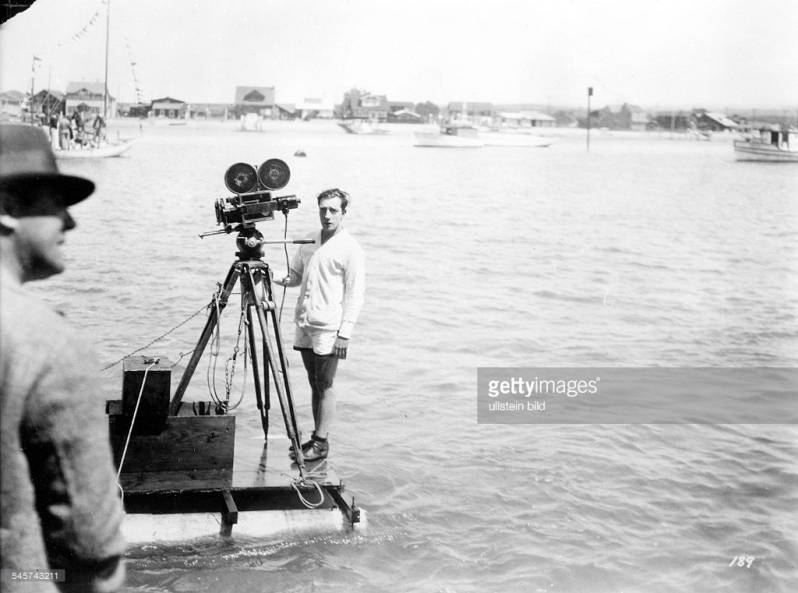
In College Keaton plays “a son” whose name is Ronald, a bookworm who attempts success in athletics in order to impress the girl of his dreams. Hardly an original story even at the time as College is similar in theme to Harold Lloyd’s The Freshman released a couple of years earlier, but this is still worth a look because of Buster Keaton.
As College starts we see Ronald graduating high school as his school’s “most brilliant scholar.” Due to his brilliance Ronald is required to deliver a speech and chooses “Curse of Athletics” as his topic. The speech is designed to denounce the role of athletes as contributors to society. “It’s books not sports that make a difference,” Ronald exclaims to the delight of the faculty sitting behind him who hang on to his every word.
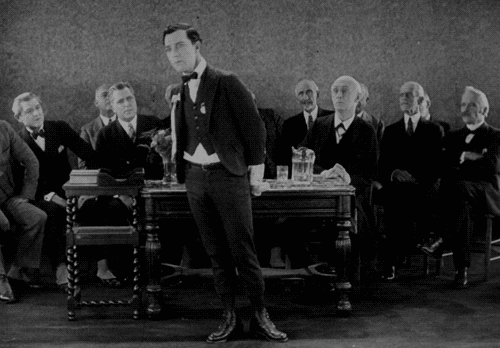
By the time Ronald finishes his soliloquy the only person still seated in the auditorium is his proud mother (Florence Turner).
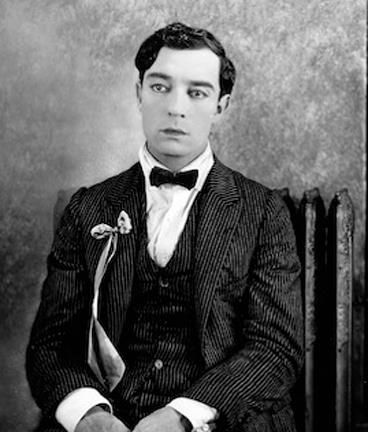
Waiting outside, however, is Mary (Anne Cornwall), the most popular girl in school who Buster wants to make his own. Mary tells him his speech was ridiculous, that everyone prefers an athlete to a bookworm and that unless he changes his mind about athletes she won’t change his mind about him. Her warning only serves to make Ronald want Mary more so it’s no surprise when he decides to go to the same college as she determined to prove himself in every sport possible in order to impress her. Among the possessions he brings with him to college are instruction manuals, “How to Play…” books so he can get the upper hand. Unfortunately the hand is not a willing partner.
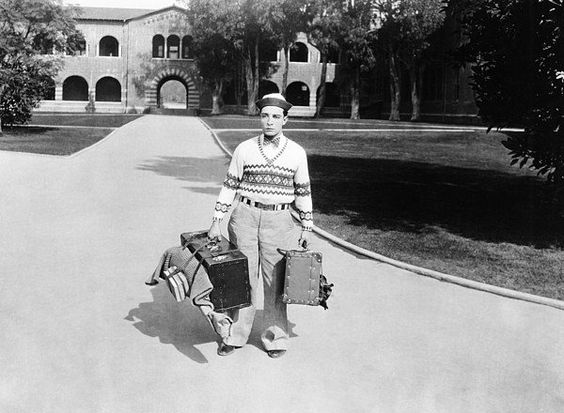
Also not conducive to Ronald’s success in sports are his peers at Clayton College and the Dean, Edwards (Snitz Edwards), who welcomes the freshman with a speech about being a good role model for books at the “Sports infected” school.
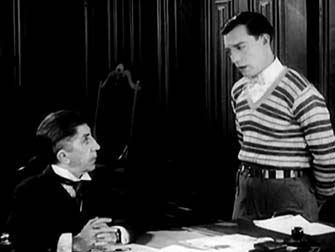
And…every other student in his dorm is an athlete, including his roommate Jeff (Harold Goodwin) who’s a bully with eyes for Mary. Needless to say they all think it’s a joke that puny Ronald wants to be an athlete.
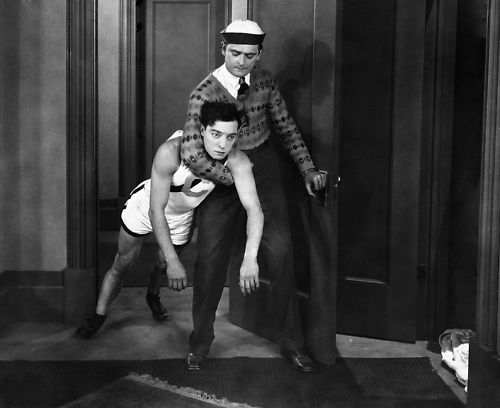
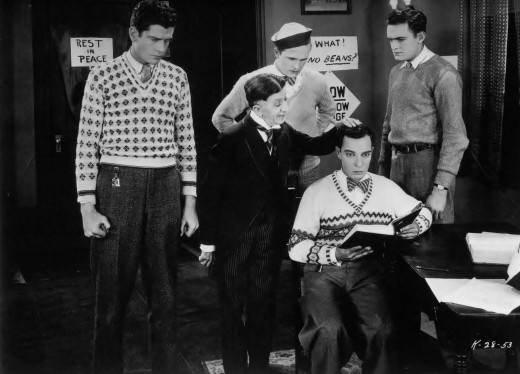
Making matters more complicated is the fact that Ronald has to work to pay his way through Clayton College, but is not successful in that endeavor either. He tries his hand at being a soda jerk with hilarious results as he attempts some fancy bartending with flair. He’s soon fired from that position after he tries to hide from Mary when she walks into the diner. Ronald doesn’t want Mary to know he has to work for a living. Later Ronald gives waitressing a try in blackface, unfortunately, when he sees a wanted ad announcing a job for a black waiter. That doesn’t go well either.
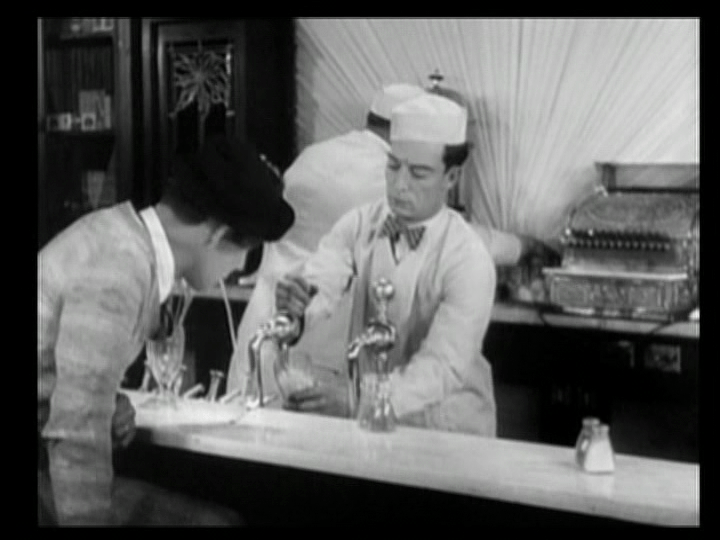
Despite the bullying and the side jobs Ronald spends as much time as he can trying to find his niche in sports. He gives baseball an earnest try and although Keaton himself was a baseball fanatic the best Ronald does is make it to first base with a baseball in his butt. He then attempts every track and field event you can imagine. He knocks down every hurdle except the last. When he gives the javelin a try he looks pretty good except that after all the fanfare the thing lands only about three feet away from him and the discuss ends up going backwards hitting the Dean. Finally, his attempt at the pole vault proves an exercise in frustration.
I should mention that Ronald doesn’t try out for football. Or at least that’s true in the finished movie. Some say that Keaton cut out the football scenes so that College wouldn’t be too similar to Lloyd’s The Freshman. There are a few indications that at one time there was football involved, however, like in the scene during Ronald’s attempt at waitressing when he goes through the door in the kitchen as if he’s running with a football. Anyway, Ronald spends so much time trying to excel in sports that his grades suffer, which prompts the Dean to question him. The young man explains the reason for his trying out in sports – the girl – which prompts Dean Edwards to remember his own lost love. Empathizing with Ronald Dean Edwards orders the rowing coach to make Ronald the coxswain for an upcoming competition. The coach agrees, but also plans to sabotage Ronald. The plan backfires, however, and Ronald plays coxswain with more than a few mishaps before the team ends up the victor. One of the funniest scenes takes place during the rowing attempts as you see Ronald with the piece of the rowboat he was straddling stuck in his butt.
Unbeknownst to Ronald – as he is trying his best in all sports unsuccessfully Mary is warming up to him, appreciating his valiant, if futile, efforts to impress her. More complications ensue allowing for more Buster prat falls and masterful use of props, but in the end not only does Ronald end up with Mary, but he does so by exhibiting extraordinary heroism when he saves her from the grasp of super jock Jeff.

When College was released in September 1927 Buster Keaton was at the top. Sadly his career would take a significant turn south all-too-soon when he’d lose the independence that had brought him fame to this point. If you’d like to read a bit about Keaton’s decision to sign with MGM and what that decision wrought you can do so by visiting the post I did a while back on Edward Sedgwick’s What, No Beer! (1933). For our purposes, however, suffice it to say that we are lucky to have movies like College. This is not Buster’s greatest achievement, but it illustrates what makes Keaton one of the all-time great actors, artists and athletes.
Extra! Extra!
I read somewhere that Buster Keaton loved baseball so much that he included a question about the sport every time he interviewed someone for a job in one of his movies. Whether that’s true or not the tidbit prompted me to look into the matter further and in doing so I found this terrific article from the Society of American Baseball Research, which discusses Buster’s talent for the game. If nothing else it’s a fun read.
◊
Be sure to visit this blog and Wide Screen World this weekend to read the impressive entries we’ve got in store in the Athletes in Film Blogathon.
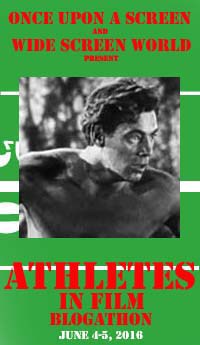


A perfect launch for this weekend’s blogathon. So looking forward to it.
When I watch Buster I take his amazing physical feats for granted and then (Boom!) in the middle of a stunt his athletic ability and grace at hiding it will hit me smack in the face, followed by a genuine sense of awe.
Me too! There are quite a few entries scheduled that I haven’t seen. Time for school!
I feel the same way and I’d venture to say that those who may know nothing about him, watch him at it would be shocked there were no special effects used. HE was the special effect.
Aurora
It’s a shame Buster K. isn’t more universally regarded as an athlete because he is A-MAZ-ING. Even in that gif you posted in the gallery, the one where he knocks down each hurdle on the track, you have to admire his timing. It would take as much skill to gracefully knock each one down as it would to clear them.
Also, thanks for the baseball research link. Great article! I didn’t know BK was such a baseball fan.
Great point about the timing needed to knock down each hurdle. He truly was AMAZEBALLS. Fun article, right? Glad you liked it.
Aurora
Keaton was in really good shape, wasn’t he? Looking at him here, I’m reminded of how a fair amount of today’s actors go through strenuous workouts to get in shape for superhero films, or most action films in general. You hardly ever see them do so for comedies. Keaton was ahead of his time in certain ways.
I agree and think he was ahead of his time in many ways. Same goes for Chaplin and Lloyd. Although of the three I think Buster’s physicality and conditioning was the most impressive.
What a great post, Aurora! I’ve always found Buster Keaton’s work totally amazing. So athletic and graceful! Thanks for hosting the blogathon and for your kind comments about my Brian’s Song entry. 🙂
College is a wonderful film! I reviewed it for my blog some years ago. Another day I was showing the clothes shrinking gag to my mom, and she liked it as well.
It was a great and very inforamative review. I didn’t know about the stunt he regretted not doing.
Thanks for hosting this great event!
Kisses!
Le